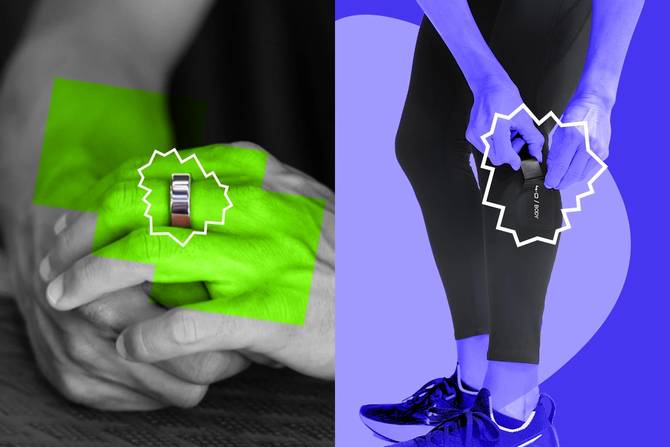Good afternoon. Sad news for AI systems—although…maybe not, since they can’t understand or process emotions…But, as I was saying, sad news for AI systems: They can’t copyright their art. At least, not according to a recent decision by the US Copyright Office’s board.
Last week, the office reconsidered a 2019 decision in which it ruled that an algorithm called “Creativity Machine” couldn’t copyright an image it created. The answer? Still no.
In today’s edition (click the links to read on-site):
 Wearable-makers look beyond the wrist Wearable-makers look beyond the wrist
 Meta’s translation ambition Meta’s translation ambition
 Battery recycling recap Battery recycling recap
—Jordan McDonald, Hayden Field, Dan McCarthy
|
|
Illustration: Dianna "Mick" McDougall, Photo: Oura, Whoop
Wearables, and digital health tracking in general, have skyrocketed in popularity since the early ’10s, and their rise has largely focused on one specific body part: the wrist.
As of Q3 2021, 56% of wearables were watches or wristbands, per IDC data, which also noted that the Apple Watch alone accounts for over 53% of the wearables market in revenue terms. Over 138 million wearables were shipped in 2021, according to IDC, compared to ~78 million units in 2015.
But, but, but...A handful of companies, like Whoop, Oura, and Moov, are looking to branch out from the wrist and produce slimmed-down and less noticeable wearables. In part, this is likely an effort to differentiate from the dominant players—or, really, player, in Apple—but the companies also claim that different body placements can yield better tracking for certain goals.
-
The share of wearable devices that are not wrist- or ear-based increased from 7% in Q3 2020 to 12% a year later, per IDC, indicating a greater appetite for different form-factors.
“I definitely see more and more companies that are experimenting in this area,” Nick Babich, design director at product design firm Milkinside, told Emerging Tech Brew. “But in terms of mass consumption…in comparison to smartwatches, I don’t see the same number of users for those kind of devices. So we’re probably at the early stages, when our mass audience realizes that they want to switch to those devices.”
Zoom out: Smaller and smaller designs have been enabled by big-picture trends like the miniaturization of semiconductors and of batteries.
-
On that second point, thanks to a new battery partnership with battery startup Sila Nanotechnologies, Whoop was able to make its 4.0 fitness tracker 33% smaller without, it claims, sacrificing battery life.
Bottom line: While moving away from the wrist could allow better applications of certain tech, like heart-rate monitors, much of the research around wearables is centered around the wrist, making other parts of the body comparatively uncharted territory. Plus, the wrist is—in many ways—a functional and familiar place to wear accessories.
Read the full story on why some wearable-makers are looking past the wrist.—JM
|
|
Meta
If the metaverse is going to work as many tech execs envision, it needs to offer not just real-time communication, but also real-time translation between hundreds of languages.
To get there, Meta plans to go all-in on language AI. During a live announcement Wednesday, Mark Zuckerberg and others laid out the plans for the research projects, which center on new AI models and a new AI teaching strategy.
No more middleman: Right now, according to Zuckerberg, the translation process for many languages—especially ones with less internet data—looks something like this: Language A → English → Language B. Meta wants to change that with a new open-source AI model that removes the English step, translating directly between 100 languages.
- In the future, Zuckerberg said, Meta hopes to apply that same technology to “content and experiences in the metaverse.”
Underrepresented languages: Meta also outlined new ambition for a single AI model that “can learn every language even if there isn’t a lot of text available to learn from.” Three years ago, it could translate 30 languages, Zuckerberg said. This year, the company’s goal is hundreds.
Instant translation: The third language AI tool Meta announced is also the toughest to imagine: a real-time speech translation tool for all languages, dubbed a “universal speech translator” (think: an all-knowing Rosetta Stone).
- “The ability to communicate with anyone in any language—now, that’s a superpower that people have dreamed of forever, and AI is going to deliver that within our lifetimes,” Zuckerberg said.
Secret sauce
To underpin all these goals, Meta plans to lean on a pivot to self-supervised learning.
- In the past, the company taught its AI systems using a supervised learning method (e.g., using large data sets of human-generated examples).
- Now, Meta will allow these AI systems to learn “without any human supervision,” Jérôme Pesenti, Meta’s VP of AI, said—for example, removing words from language text and guessing the blanks by inferring patterns in surrounding words.
But, but, but: There’s a reason why these technologies don’t exist yet. As your friends who downloaded Duolingo over the pandemic will tell you, language is complex and requires a lot of nuance and common sense—two things that AI is notoriously bad at. Without humans in the loop, things can get mistranslated in confusing or problematic ways.
Click here to read on-site.—HF
|
|
No, your podcast doesn’t suck. You probably just don’t know all of the secrets to finding listeners.
This essential course—led by Morning Brew cofounder Alex Lieberman—is what you need to develop strategies for growing your influence across all social platforms. Learn to build an audience through creation, curation, and consistency.
Register today and join us in March.
|
|
Emerging Tech Brew
There are few technologies more important to our collective future than batteries, and no, we don’t mean the Energizer Bunny-endorsed kind. Without scaled-up battery manufacturing, a transition to an electrified, renewable-based economy will be next to impossible.
As battery production goes into overdrive and more electric vehicles hit the road, a big question will become more and more pressing...
How do we reuse and recycle EV batteries?
Yesterday, Emerging Tech Brew’s Grace Donnelly hosted a virtual event with Kunal Phalpher, chief strategy officer of Li-Cycle, a publicly traded battery-recycling company, to answer that question. Skip to the replay video here.
- Li-Cycle was founded in Canada in 2016. It SPAC’d in August, is currently valued at ~$1.1 billion, and has commercial partnerships with LG Chem and LG Energy, as well as with Ultium, a joint-venture between General Motors and LG Energy.
Big picture: Li-Cycle is aiming to build 100,000 tons of annual shredding capacity across its spoke sites by 2025, Phalpher said, enough to build batteries for ~200,000 EVs. Right now, its capacity is approaching 55,000 tons.
He said building capacity by the end of the decade is crucial because that’s when a lot more EVs will reach the end of their lives in Europe and in North America—and demand for recycling should boom.
Click here to read the full recap and watch the event replay.—DM
|
|
|
Health care gets the tech treatment. Just about everything in our lives is getting digitized—and health care is no exception. Together with Formstack, we built a hub that explores the latest trends and emerging technologies shaping the world of digital health today. Take a look here.
|
|
Francis Scialabba
Stat: The overall stablecoin market cap is now ~$180 billion, up from roughly $38 billion a year ago. Stablecoin = a type of crypto that’s pegged to another asset in an attempt to make its value…more stable.
Quote: “What we’ve learned over the last five years is that if charging is ultra-fast, reliable, and non-proprietary, it will meet customer needs. And if it falls short on any of those three metrics, it probably won’t.”—Matt Nelson, director of government affairs at Electrify America, to Emerging Tech Brew
Listen: What will it look like for synthetic biology to scale?
Add some flexibility to your fitness. Future is a fitness program that provides unlimited 1:1 digital fitness coaching—all through the Future app—that you can access anywhere, whether you’re at your local gym or the top of a mountain. Get your customized workout plan here.*
*This is sponsored advertising content.
|
|
-
Ukraine supplies +90% of the US’s semiconductor-grade neon, according to estimates, which is necessary for lasers used in the chipmaking process to function.
-
Ukraine’s government called on its hacker community to help defend against Russian cyberattacks.
-
The USPS is not budging on its plan to buy a new mail-delivery fleet that is 90% gas-powered, even after explicit requests from the Biden admin.
-
PlantLab, an Amsterdam-based indoor farming company, raised $57 million as the vertical farming space continues to grow.
-
Tesla could lose the water contract for an already-delayed plant in Germany as local groups seek to void the deal on environmental grounds.
|
|
Three of the following news stories are true, and one...we made up. Can you spot the odd one out?
-
Researchers have created a battery that is both the world’s smallest and self-assembling.
-
The Game of Life, the board game created in 1860, has announced plans to stop producing physical games in favor of a metaverse-based version.
-
Elon Musk said Tesla is working to make the Steam video-game library work on its car’s video screens.
-
Bacteria from rabbit poop is helping companies convert industrial waste into ethanol.
|
|
Earlier this month, the UK’s National Health Service said it would begin a pilot program requiring health care AI tools to undergo algorithmic impact assessments (AIA). It claims this is the first pilot of AIAs in a health care context.
The goal: “To eradicate health inequalities by tackling biases in systems which underpin future health and care services,” the NHS wrote.
-
The Ada Lovelace Institute, a UK-based AI research institute, developed the AIAs that the NHS will use.
-
The institute has proposed a seven step process for AIAs, which includes initial impact identification, workshops to discuss harms and benefits of a given system, and ongoing assessment, among other things.
“Algorithmic impact assessments have the potential to create greater accountability for the design and deployment of AI systems in health care, which can in turn build public trust in the use of these systems, mitigate risks of harm to people and groups, and maximize their potential for benefit,” according to Octavia Reeve, interim lead of the Ada Lovelace Institute.
|
|
Catch up on the top Emerging Tech Brew stories from the past few editions:
|
|
|
Don’t fret, you can still buy the Life board game.
|
|
|
Written by
Jordan McDonald, Hayden Field, and Dan McCarthy
Was this email forwarded to you? Sign up
here.
|
ADVERTISE
//
CAREERS
//
SHOP
//
FAQ
Update your email preferences or unsubscribe
here.
View our privacy policy
here.
Copyright ©
2022
Morning Brew. All rights reserved.
22 W 19th St, 4th Floor, New York, NY 10011
|
|








